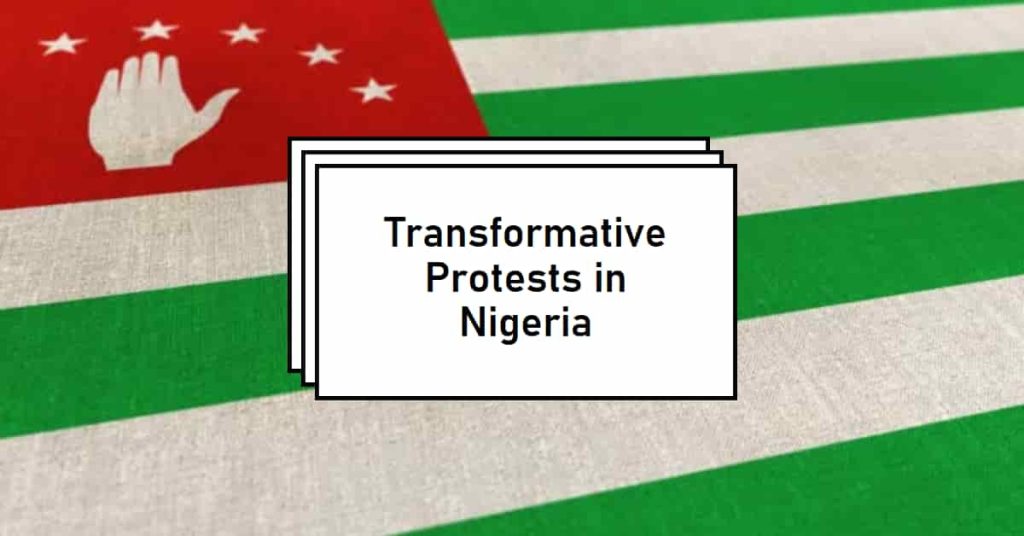What are the Defining Features of Protests that can lead to Transformation in Nigeria?

Protests have been a powerful tool for social and political change globally, including across Africa. While each protest is unique to its context, there are common features that can make them more likely to achieve transformational change. By examining successful protests globally and within Africa, we can identify key characteristics that can guide future movements in Nigeria towards achieving significant and lasting impacts.
Global Examples of Transformational Protests
Civil Rights Movement (United States, 1950s-1960s)
- Leadership and Organization:The movement had strong, charismatic leaders like Martin Luther King Jr., who provided a clear vision and strategy.
- Nonviolent Resistance:Emphasis on peaceful protests and civil disobedience gained widespread public support and sympathy.
- Legislative Impact:The movement led to significant legislative changes, including the Civil Rights Act of 1964 and the Voting Rights Act of 1965.
Women's Suffrage Movement (USA)
The Women's Suffrage Movement in the USA was marked by sustained efforts and persistence over several decades. Leaders like Susan B. Anthony and Elizabeth Cady Stanton worked tirelessly to secure voting rights for women, culminating in the 19th Amendment in 1920.
Anti-Apartheid Movement (South Africa, 1948-1994)
- International Support:Garnered global solidarity and pressure, including sanctions and divestments, which isolated the apartheid regime.
- Unified Front:Various groups, including the African National Congress (ANC), united under common goals, strengthening the movement.
- End of Apartheid:Ultimately resulted in the dismantling of apartheid and the establishment of a democratic government.
Arab Spring (2010-2012)
- Digital Mobilization: Utilized social media to organize protests, share information, and build international awareness.
- Grassroots Participation: Large-scale involvement of ordinary citizens, particularly youth, driving the momentum.
- Varied Outcomes:While some countries achieved regime changes (e.g., Tunisia), others faced prolonged instability (e.g., Syria), highlighting the complexity of transformational change.
Solidarity Movement (Poland)
- The Solidarity Movement in Poland, led by Lech Wałęsa, was well-organized and had strong leadership. This labor union movement played a crucial role in ending communist rule in Poland and inspired other Eastern European countries to pursue democratic reforms.
Indian Independence Movement
The Indian Independence Movement, led by Mahatma Gandhi, was notable for its mass mobilization and inclusivity. Gandhi's philosophy of non-violent resistance and civil disobedience attracted people from diverse backgrounds, leading to India's independence from British rule in 1947.
Sudan Uprising (2018-2019)
- Persistent Protests:Continued demonstrations despite severe crackdowns showcased the resilience and determination of the protesters.
- Inclusive Leadership:Diverse groups, including women and professionals, played pivotal roles, promoting inclusivity.
- Political Transition:Led to the ousting of President Omar al-Bashir and initiated a transition towards civilian rule.
Ghana's "Kume Preko" Protests (1995)
- Broad Coalition:Various political and civil society groups united against economic hardship and government policies.
- Peaceful Demonstrations:Largely peaceful protests that put significant pressure on the government.
- Political Reforms:Contributed to greater political accountability and reforms in subsequent years.
Eritrean Independence War
The Eritrean War of Independence, which lasted for 30 years, was characterized by sustained efforts and persistence. The Eritrean People's Liberation Front (EPLF) eventually succeeded in securing Eritrea's independence from Ethiopia in 1993.
Defining Features of Transformational Protests for Nigeria
Drawing from these examples, several defining features can be identified for protests in Nigeria to be transformational:
Strong and Charismatic Leadership
Effective leadership is crucial in articulating the vision, strategy, and objectives of the movement. Leaders should be able to inspire and mobilize large segments of the population.
Clear, Unified Demands, and Achievable Goals
Protests should have well-defined and realistic goals that address the core issues at hand. This clarity helps in maintaining focus and measuring success.
Nonviolent Approach
Emphasizing nonviolence helps in garnering public support and sympathy, reduces the likelihood of violent crackdowns, and maintains the moral high ground.
Broad-Based Participation and Inclusivity
Inclusive participation from various segments of society, including marginalized groups, strengthens the movement and ensures diverse perspectives and interests are represented.
Effective Use of Technology and Media
Leveraging social media and digital platforms for organizing, communication, and raising awareness can amplify the reach and impact of the protest.
International Solidarity and Support
Building international alliances and gaining support from global organizations can increase pressure on the government and provide additional resources.
Sustained Momentum and Resilience
Protests should be able to sustain momentum over time, even in the face of adversity. Persistence is key to achieving long-term change.
Strategic Alliances and Coalition Building
Forming alliances with other groups, including civil society organizations, labor unions, and political entities, can enhance the strength and impact of the protest.
Policy and Legislative Advocacy
Beyond street protests, engaging in policy advocacy to push for legislative and institutional reforms is essential for translating demands into concrete changes.
Public Education and Awareness
Raising public awareness about the issues at stake and educating citizens on their rights and the importance of the protest can build broader support and participation.
Conclusion
For protests in Nigeria to be truly transformational, they must embody these defining features. By learning from successful global and African examples, Nigerian movements can enhance their effectiveness and drive significant, lasting changes. Transformational protests require strategic planning, inclusive participation, resilience, and a clear vision for the future. With these elements in place, protests can move beyond immediate grievances to catalyze profound and enduring transformations in society.



